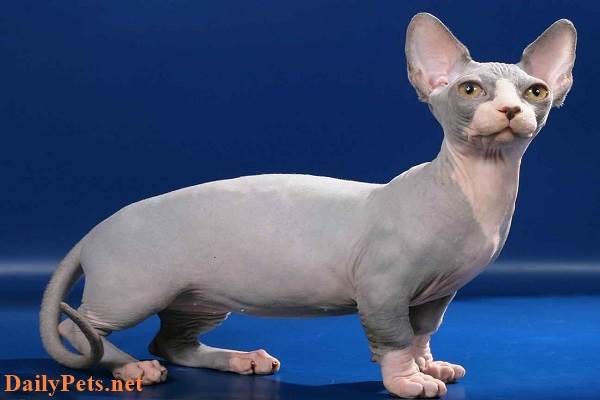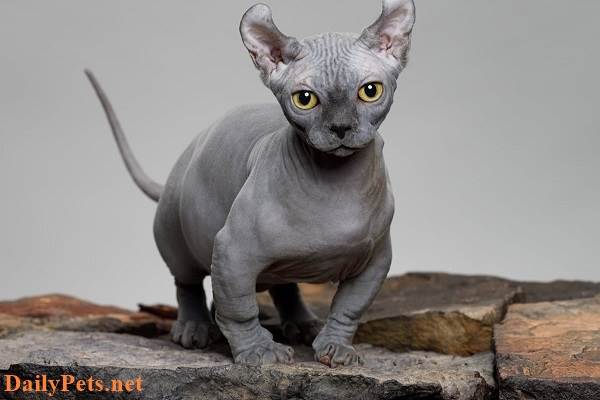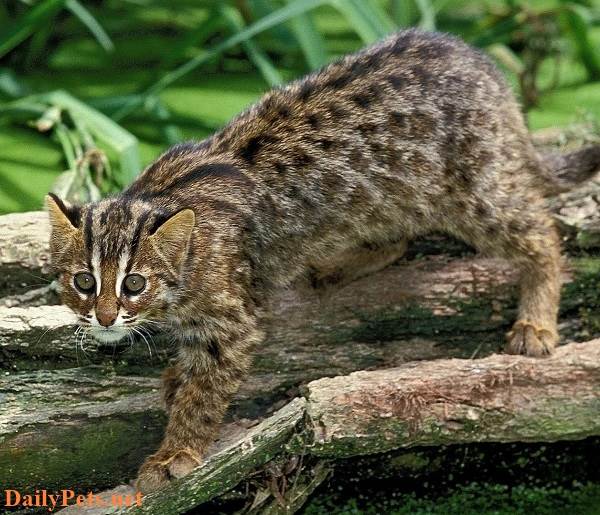It represents a harmonious blend of these two breeds, manifesting the overall appearance of a sphynx with notably short legs.
The controversy surrounding this breed arises from concerns about the deliberate breeding of cats with short limbs, which may make them susceptible to health issues and discomfort due to their anatomical abnormality. Additionally, the sphynx breed carries hereditary problems and is prone to skin damage from sunlight. Consequently, the Bambino is classified as an “experimental” breed and is discouraged by the Cat Fanciers’ Association.

Bambino Cat.
Origin and History of the Bambino Cat
The Bambino breed was introduced in 2005 by Stephanie and Pat Osborne, Arkansas’s now-defunct Holy Moly Cattery proprietors. The Osbornes crossed sphynx cats with the recessive hairless gene, with munchkin cats carrying the dominant short-legged gene. The resulting breed was named Bambino, derived from the Italian word for “baby.”
The International Cat Association (TICA) officially recognized the Bambino as an “experimental” breed in 2006. Nevertheless, both the Cat Fanciers’ Association (CFA) and the American Cat Fanciers’ Association (ACFA) refrain from registering the breed due to their reluctance to encourage the propagation of genetic anomalies for aesthetic reasons.
Purposefully breeding cats with genetic variations, such as the short-legged Bambino and munchkin, is a contentious and divisive practice, drawing varied opinions from cat experts, veterinarians, and the public. Nonetheless, the Bambino appears to be gaining popularity as a “trendy” breed.
Bambino Cat Characteristics
The Bambino cat is known for its affectionate nature and distinctive personality, relishing the companionship of its human family and disliking being alone for extended periods. This small to medium-sized cat enjoys playtime but does not require excessive exercise. Due to its hairless nature, the Bambino is more vulnerable to injuries than typical cats and should be safeguarded from potential bites or scratches from other pets, as well as prolonged exposure to the sun, which can lead to sunburn on their delicate skin.
Bambino Cat Care
Diet and Nutrition
Just like all cats, Bambinos require a high-quality diet. They are obligate carnivores, and their food should consist of high-protein formulations specifically designed for feline nutrition. Feeding measured portions at scheduled meal times (twice daily) is crucial to prevent them from becoming overweight, which can place additional stress on the spine and increase the risk of feline diabetes.
Grooming
While some are drawn to the Bambino for its hypoallergenic potential, it’s essential to understand that no cat is entirely hypoallergenic. The Bambino still produces some dander that might irritate sensitive individuals. Surprisingly, the slight “down” of the Bambino’s coat demands more care than commonly presumed.
Because they lack a conventional insulating coat, Bambinos tend to have oily skin, rendering them more susceptible to skin issues like bacterial or fungal infections. Regular bathing and gentle cleaning with a damp cloth are necessary to maintain their skin and downy coat’s cleanliness.
Exercise
Despite their short legs, Bambinos are known for their energy and surprising agility. They enjoy playing with toys and benefit from various forms of feline enrichment. Their shorter legs can tire more quickly than those of “standard” cats, so they do not require excessive exercise. Nonetheless, they enjoy scratching and climbing on low cat trees; however, jumping from heights is discouraged.
Bambinos are prone to sunburn outdoors, so if you take your Bambino outside, using vet-approved feline sunscreen (human sunscreen is toxic to pets) or limiting direct sunlight exposure to a few minutes is essential.
Additionally, they are vulnerable to cold weather, and their skin can be easily injured by brambles or sticks, making them more suitable for an indoor lifestyle.
Common Health Problems
Because the Bambino is a relatively new breed, the full extent of its genetic health issues remains unknown. However, it is reasonable to assume that they may be susceptible to conditions affecting both the sphynx and munchkin breeds, including:
- Lordosis: Although this condition can affect any cat, it is more common in munchkins. It involves the spine curving excessively inward, exerting pressure on vital organs and potentially leading to fatal outcomes.
- Pectus excavatum: Seen predominantly in munchkins, this condition results in the breastbone caving in, causing respiratory problems, loss of appetite, and weight loss.
- Hereditary myopathy: This condition of generalized muscle weakness is observed in sphynx cats.
Bambino Cat Price
Bambino cats are still relatively rare, which means you may encounter waiting lists or need to travel to acquire a kitten. Due to the breed’s rarity and growing popularity, it is essential to be cautious of unscrupulous “backyard” breeders who may engage in unethical practices to exploit the market. Kittens from such breeders are more likely to be inbred or carry undisclosed health problems.
Some reputable sphynx breeders also specialize in Bambinos, making them a valuable resource when searching for a Bambino kitten.
A Bambino kitten from a reputable breeder may cost between $1,800 and $3,000, reflecting the breed’s novelty and rarity.





